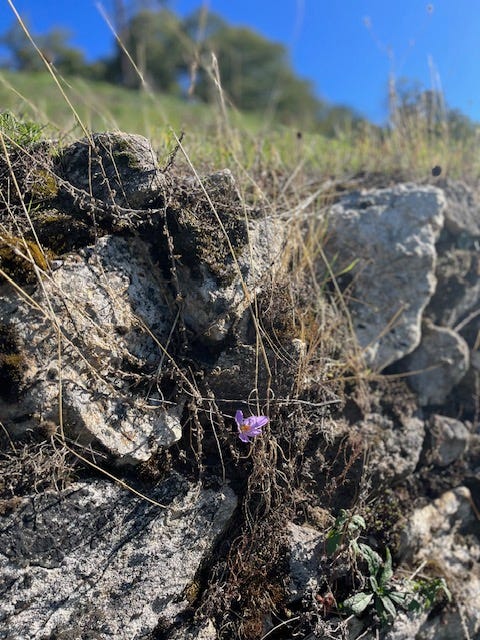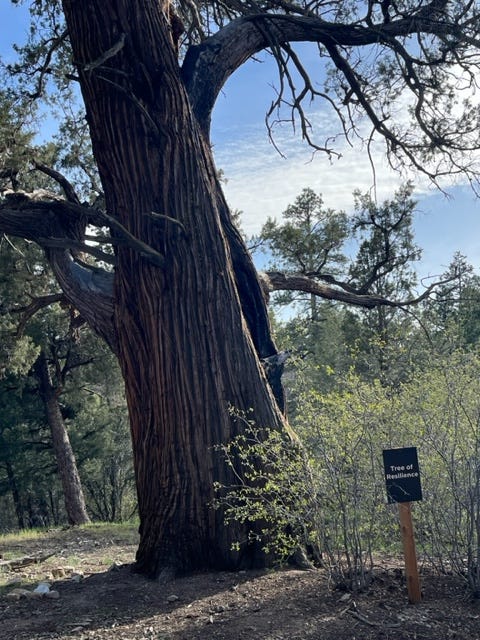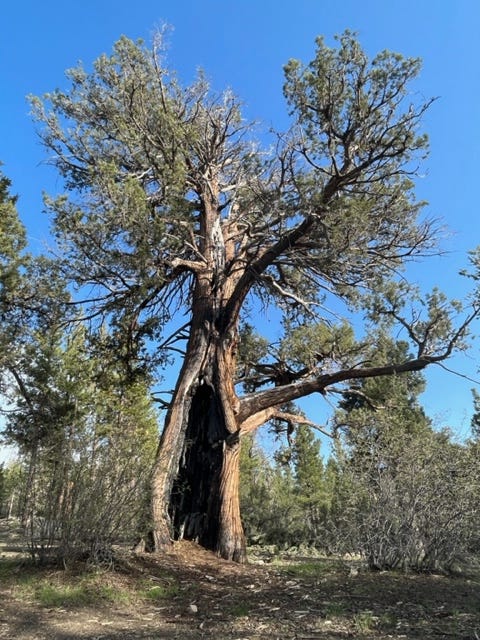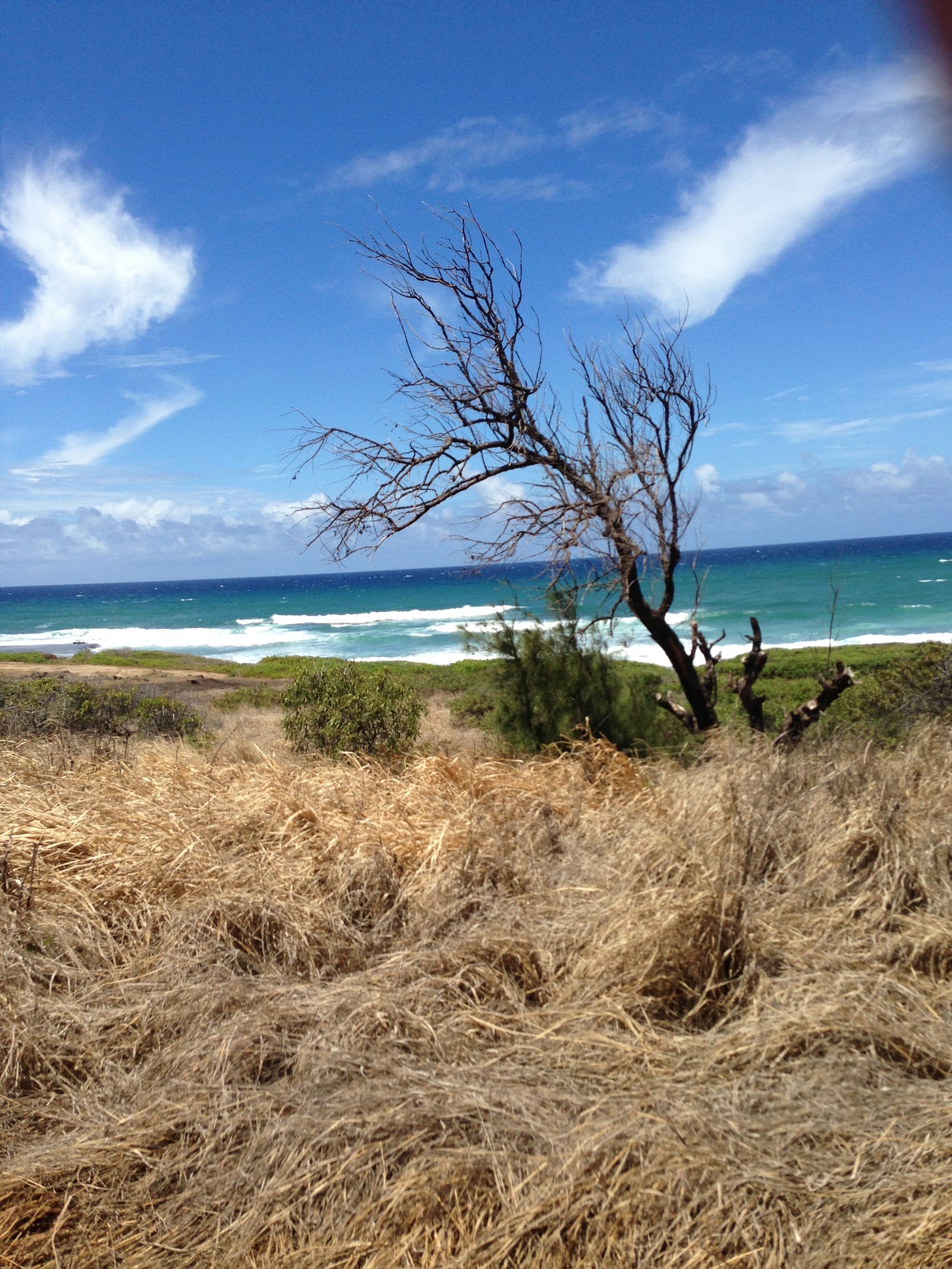“For me, trees have always been the most penetrating preachers. In their highest boughs the world rustles, their roots rest in infinity; but they do not lose themselves there, they struggle with all the force of their lives for one thing only: to fulfill themselves according to their own laws, to build up their own form, to represent themselves.” ~ Herman Hesse
I am learning a lot about trees these days. Living in a mountain town of Big Bear, opened up for me much that I didn’t know about trees as well as living in natural beauty of mountains. I have never really spent time with trees. On the land where our retreat center is, there is an old Juniper tree called the Tree of Resilience. It’s believed that it is at least 500 years old. There is a large hole in its solid massive body that shows remaining signs of fire. It could be a fire that was naturally or human caused, or it could also be an evidence of a spiritual ritual that happened here in the distant past. No matter what happened, this tree stands still and strong, while exposing, so beautifully, its wounds to all of us who are there to witness it. No wonder it is called the Tree of Resilience.
Resilience is an evolving concept that has been spoken about for a while now. It is usually defined by the ability to bounce back quickly from a difficulty, or hardship; one needs to be tough in order to be resilient. Toughness would involve one being able to endure hardship, or to resist and fight difficult conditions. I have always struggled with this view of resiliency - it is very loud and it lacks something very important - an element of vulnerability, grace, acceptance, allowing, and authenticity. If you look at this tree, you can tell that it has been through a lot, but not by its perfect looks (because it learnt the life lesson), quick recovery and bouncing back, or its hidden wounds, but quite the opposite - by its exposed and visible scars, by grace that it stands tall with, and by how vulnerable and wide open it remains to be. It offers us its past without a worry that it won’t be accepted, seen and understood. It offers us its past with the hope we’ll learn something from it. It took its time to recover, no matter how long that needed to be. And now it is here to teach us. This tree teaches us about humanity.
Juniper trees remind me of those trees in old Walt Disney movies from my childhood, where they would come to life and offer their stability, refuge and wisdom to those who need it. Usually, very tall, with their wide trunks, and branches that look like long arms with the fingers-like twigs that branch out. I never thought about it before, but it is so wonderful to see how trees send their message of resilience in those movies. The story would usually involve one character who would have been marginalized for various reasons, who struggled or endured a lot in life (like Cinderella, Snow White, or Sleeping Beauty, for example), and lost all hope for the better future. The trees would come in as helpers and offer support to them (as well as all those little birds who would land there to rest), showing us that healing is possible, hope is crucial and that better days are ahead of us.
Trees are often like solitary men. Especially in places where the forest is not so thick, like here, in Big Bear. Often, they stand alone and yet have everything they need inside of them. They hide in them an ancient law of life - they are created from a smallest seed and yet, through decades and centuries, they grow into magnificent giants. And in difficult times, just looking at them can bring us hope and strength. A tree can show us that home is within us. They have much longer lives than us, and can offer us wisdom, hope and rest.
“Like tiny seeds with potent power to push through tough ground and become mighty trees, we hold innate reserves of unimaginable strength. We are resilient.”
~ Catherine DeVrye
There is a saying that “A tree that bends with the wind does not break.” This speaks volumes to resiliency. How much of our own power, effort and resistance actually stand in the way when things get difficult. And how much more helpful would it be to be flexible instead, to bend along with the difficulty, to lean in fully. I know personally that, when things get difficult, my initial response it to toughen up, to offer resistance, to want to power through things rather than go along with them, feel them, allow them and soften. They are already here anyways, I can’t avoid them or deny them. Like Pema Chodron says “lean into the sharp edges and fully experience them.” This doesn’t mean that we should suffer and struggle and enjoy the pain that comes with it; there is nothing here about spiritual asceticism. It simply means that softening, being more vulnerable and open to our suffering, allowing us to feel it, spend some time with it to get to know it, might bring us home to resiliency and our inner strength, instead of fighting it, pretending that we are well, or being tough about it. That is not resiliency for me. That is a conditioned response that we all, somehow, internalized from the (unhealthy) society we live in.
Another important thing is that becoming resilient isn’t a linear process. One does not just become resilient by practicing to power through life and difficulties, and by “pulling oneself up by the bootstraps”. Difficulties in life don’t magically stop showing up as you get more and more resilient. It is a cycle. There is a time, a season to say so, and a space, given to us in order to “tend the garden of our soul”, to actively and consciously accept the difficulties, and to go on growing in whatever way is accessible and appropriate to us. Some call it “wintering.” As any other season, winter comes and goes; we live through a deep and unsettling winter many times in our lives. This idea is opposite of the dominant teaching in our culture where there is a linear path of progression to the state of ever-lasting strength and growth, where we are invulnerable to life, and where we should not be expected to repeat the same mistakes. The key to wintering is to come out of this cold season of our inner self a bit more integrated and wiser, and also reinvigorated and strong.
If we look at the trees, they can teach us how to live with ourselves when things get hard, how to live with each other; they can teach us the root of authenticity and what it means to be a human. The path through the woods is not linear, just like our lives are not linear. As Katherine May beautifully writes in her book Wintering: The Power of Rest and Retreat in Difficult Times, “We have seasons when we flourish and seasons when the leaves fall from us, revealing our bare bones. Given time, they grow again.”

“Wintering… is the courage to stare down the worst parts of our experience and to commit to healing them the best we can. Wintering is a moment of intuition, our true needs felt keenly as a knife.”
~ Katherine May
Having studied Buddhism for the past ten years, I have learnt a lot about a concept, or rather a practice, called equanimity. Here we’re referring to emotional self regulation; our ability to calm down when we are upset or angry, and to remain grounded in our self in the midst of turbulent life circumstances and emotions. We are referring to those times when the pain is held in our hearts, while the mind is still, steady, and clear. Equanimity requires conscious and intentional action. It is not something that just magically appears but rather takes time to develop and cultivate (just like resilience involves time).
It is a wonderful quality and usually it grows with one’s meditation practice. However, equanimity cannot be forced. Just like resilience cannot be forced. We come to recognize it through meditation practice, through stillness. For me, equanimity goes hand in hand with resiliency. I recently read somewhere that “equanimity is the space in which resilience is strengthened”. This speaks to mindfulness and how it can guide us in building the qualities which lead to improving resilience. It also teaches us to, instead of shutting the door to uncomfortable and difficult emotions, we open the door and welcome them inside, instead.
Pema Chodron, a Western Buddhist teacher and nun, says that “The traditional image for equanimity is a banquet to which everyone is invited. That means that everyone and everything, without exception, is on the guest list.” When we meditate, it becomes more clear to us who is at the door and wants to come inside. But, remember, ignoring those uninvited guests, such as anxiety, sorrow, anger, fear, shame won’t make them go away. Of course, we could open the door slowly to some of them and if it becomes unbearable, we may shut the door and wait for another opportunity to open it again. It is all practice; a work in progress, and it takes time and space. Just like wintering does.
Often using nature as a metaphor helps us to understand equanimity. For example, equanimity can be described like a great mountain, solid and stable, undisturbed by the changing seasons. “No matter how many winds are blowing, no matter how many clouds are swirling, no matter how many lions are prowling” - mountain remains sitting. Or it can be like the ocean, vast, deep, and limitless, undisturbed by whatever swims, floats and lives in it. Equanimity can also be like a strong fire — roaring, submerging, and transforming, undisturbed by whatever is thrown into it. Or like enormous limitless space — open, allowing, and receiving, spreading, undisturbed by the objects that appear and disappear.
These metaphors show us that, while life happens and brings variety of disturbances, waves, instabilities, and uncertainties, by consciously allowing ourselves to feel them all, and spend time with them, we can slowly, with time, become stronger, more graceful, authentic and resilient. This concept came to life for me when I realized that I don’t need to deny the difficulties in my life and pretend like they are not here - it is not about spiritual bypass - but rather, I can allow space for them to be present and I can also slowly heal.
Life is not a straight, simple and effortless path; rather, it is more like a labyrinth often, where the circle and spiral, challenges and heartbreaks, losses and fears, combine into a winding, often difficult, but always meaningful journey. We have seasons when we thrive and blossom, and then we have seasons when we are worn-out, mourning, exhausted and in anguish. Given time and space, we can journey our path to our own inner center and back again out into the world, but this time wiser. Once a winter is over, we have a responsibility to pass that wisdom on to those who have yet to winter. We need to share our experience, strength and hope. Disasters and misfortune happens to all of us, and it is helpful to learn from those who have been there before us about how to adapt when they do.
Our own wintering also makes us more compassionate and understanding towards others, when there is their time to suffer. So, we can reach out since we know what it is like. We’ve been there. If we watch our winters closely and really listen to their message, we will notice that the effects are often so unreasonably greater compared to the causes. We might feel that life is unfair and that we don’t deserve that much pain in our lives. We might even blame others (or the Universe) for it. A victim position won’t help us in becoming more resilient. In the end, we will learn that often the smallest mistakes simply can lead to huge tragedies, and that life keeps going (for all of us) no matter how we feel about it and if we are ready or not. We also learn to look more lovingly on other people’s crises, because they so often can predict our own future.









